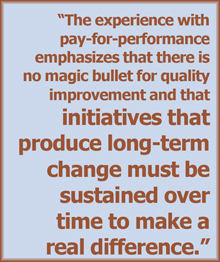Synopsis
An ambitious program in the United Kingdom that links physician payment increases to achievement of quality-of-care targets reduced a shortage of general practitioners, improved income and morale, and reduced working hours. Socioeconomic disparities in chronic disease treatment narrowed as well, but the program's impact on medical professionalism and long-term patient outcomes has yet to be determined.
 The Issue
The Issue
After a decade of low morale and perceived poor working conditions, a 2001 survey found that 90 percent of U.K. general practitioners (GPs) felt they were overworked, undervalued, and underresourced. To address a shortage of GPs, improve physician morale, and address public concerns about quality of care, the U.K. Department of Health in 2004 negotiated a new GP contract that increased payments to practices based on performance on more than 100 clinical and health improvement indicators. The authors of this Commonwealth Fund–supported study examined the intended and unintended effects of this pay-for-performance program on the supply of GPs, quality of care, practice behavior, and income.
Key Findings
- The U.K. program had the desired effect of reducing a shortage of general practitioners. In its first three years, the number of GPs increased by 15 percent, to nearly 31,000—twice as many as the Department of Health expected. The vacancy rate fell from 3.1 percent to 0.8 percent.
- The program brought GPs' income closer in line with that of hospital specialists. In two years, the average income of a GP who was also a senior practice partner increased by almost $67,000, nearly 60 percent.
- Performance on most indicators in the framework was high in the first year and generally improved during the next two years, exceeding the government’s predictions.
- In the first year, the worst-performing practices improved at the fastest rate. Because these practices tended to be concentrated in the poorest areas, inequalities in quality of care for common chronic conditions narrowed.
- Quality scores for two activities for which no incentives were provided—asthma and coronary heart disease—deteriorated. However, diabetes care, another area where performance rewards were lacking, improved.
- Evidence of impact on long-term outcomes is unclear. Practices that did well on coronary heart disease indicators did not have lower hospital admission rates, but practices that controlled epilepsy and diabetes well did have reduced emergency admissions for complications from these conditions.
- In 2009, 81 percent and 72 percent of patients, respectively, said they could get an appointment "fairly quickly" if needed and could book appointments in advance. However, while 62 percent preferred seeing a particular doctor, only 57 percent said they could do so "always or almost always."
- Overall, 91 percent of patients reported satisfaction with their care.
Addressing the Problem
The program achieved successes in improving morale, reducing a shortage of GPs, and improving chronic disease management. However, introducing a large and complex incentive scheme may have produced some adverse consequences. For instance, the authors point out that it may make physicians more focused on meeting targets than on meeting patients’ needs. Looking forward, the authors conclude the following lessons for other health systems looking to initiate similar reforms: install the necessary infrastructure (e.g., by subsidizing health information technology systems); establish baseline performance and set targets accordingly; involve physicians and patient groups from an early stage; base indicators on important outcomes, if available, or on processes with strong evidence of improved outcomes; test indicators before introducing them widely; regularly review all elements of the initiative and their impact on patient outcomes; and monitor effects on professional behavior and morale.
The Bottom Line
The U.K.'s comprehensive physician practice incentive program improved physician morale, helped address a shortage of general practitioners, and improved chronic disease care. But the longer-term effects on the physician–patient relationship cannot yet be assessed.